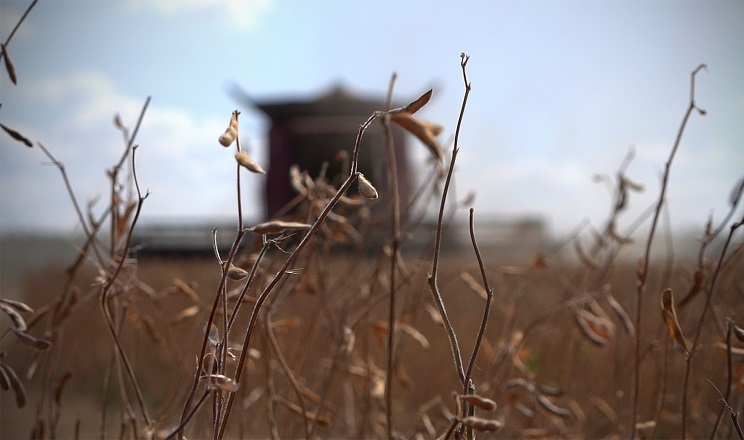Wet Weather Slows Initial Soy Harvest in Brazil, 0.04% Harvested

La Nina is resulting in two weather extremes in Brazil; drought in the southernmost state of Rio Grande do Sul and excessive rainfall in central Brazil. Rainfall over the weekend was focused mostly on central and eastern Brazil. Dry weather over the weekend in southern Brazil maintained moisture stress on the crops in Rio Grande do Sul. The forecast for this week is for widespread rainfall with heaviest amounts in central Brazil, but only light amounts in far southern Brazil.
As of late last week, a few soybeans were harvested in the states of Mato Grosso and Rondonia. Nationwide 0.04% of Brazil’s soybeans have been harvested compared to 0.2% last year according to AgRural. Wet weather in central Brazil has slowed the initial start to the harvest.
The Brazilian soybean estimate was left unchanged this week with a neutral bias due to conflicting signals. Dry conditions in far southern Brazil could trim the production estimate, whereas good conditions in central Brazil could increase the production estimate. The southernmost state of Rio Grande do Sul is suffering from its third consecutive year of drought, whereas regions of north-central Brazil could receive a month’s worth of rain over the next few days.
With that as a background, I decided to hold the soybean estimate unchanged this week and wait to see which side of the argument prevails
Mato Grosso – Rainfall has increased in Mato Grosso with less than 1% of the soybeans harvested in the state. Wet weather has slowed the initial soybean harvest in Mato Grosso and the harvest pace should pick up during the second half of January. The soybeans harvested thus far have been early maturing soybeans that were irrigated and they will likely be followed by a second crop of cotton.
The slowest harvest pace will be in eastern Mato Grosso because the summer rains arrived late and the soybeans were planted at the end of October and into November.
Parana – The condition of the soybean crop in Parana declined after dry weather during the month of December impacted the crop in areas of western Parana. As of earlier last week, the soybeans in Parana were 22% in vegetative development, 37% flowering, 40% filling pods, and 1% maturing according to the Department of Rural Economics (Deral). The soybeans were rated 4% poor, 16% average, and 80% good. On December 19th, the soybeans were rated 90% good.
In the municipality of Toledo in western Parana, December was generally dry with some producers going as much as 40 days without rain. According to the president of the Rural Union of Toledo/PR, soybean yields could be down as much as 30% in the hardest hit areas. The soybean harvest is expected to start at the end of January or early in February which should allow enough time to plant the safrinha corn within the ideal planting window.
In the municipality of Francisco Beltrao in southwestern Parana, soybeans planted in September suffered losses due to the 24 inches of rain received in October. According to the President of the Rural Union of Francisco Beltrao, those early planted soybeans are expected to yield 40-50 sacks per hectare (35.7-44.7 bu/ac). Soybeans planted after the rains let up at the end of October have done very well and they may yield as high as 80 sacks per hectare (71.5 bu/ac)
Rio Grande do Sul – Soybeans in Rio Grande do Sul were 96% planted as of late last week compared to 94% last year, which was a year where the soybean planting was also delayed by dry conditions. In a normal year, the soybean planting should have been completed by now. There are reports of farmers replanting their soybeans due to poor plant populations.
Dry conditions are slowing the crop development, but unfortunately there is limited rainfall in the forecast. The earlier planted soybeans are flowering and they need rain as soon as possible. The western half of the state is the driest region.
Minas Gerais – The weather in Minas Gerais started out dryer-than-normal, but it has now turned wetter-than-normal. Recent rains have been very heavy and there are more in the forecast.
Soybean planting in the municipality of Paracatu in northwestern Minas Gerais started 15 days later than normal due to dry conditions, but since then, the weather has been beneficial and the soybeans have developed normally. Harvesting of the irrigated soybeans should start in about 30 days and harvesting of the dryland soybeans should start in about 45 days. Yields of the best soybeans could be as high as 70 sacks per hectare (62 bu/ac).
The delayed soybean harvest could make it difficult to plant the safrinha corn during the ideal planting window. Some producers indicated that if it gets too late to plant safrinha corn, they may plant grain sorghum instead.
Author: Michael Cordonnier/Soybean & Corn Advisor, Inc.
Read also
Wheat in Southern Brazil Impacted by Dry Weather and Frosts
Oilseed Industry. Leaders and Strategies in the Times of a Great Change
Black Sea & Danube Region: Oilseed and Vegoil Markets Within Ongoing Transfor...
Serbia. The drought will cause extremely high losses for farmers this year
2023/24 Safrinha Corn in Brazil 91% Harvested
Write to us
Our manager will contact you soon



